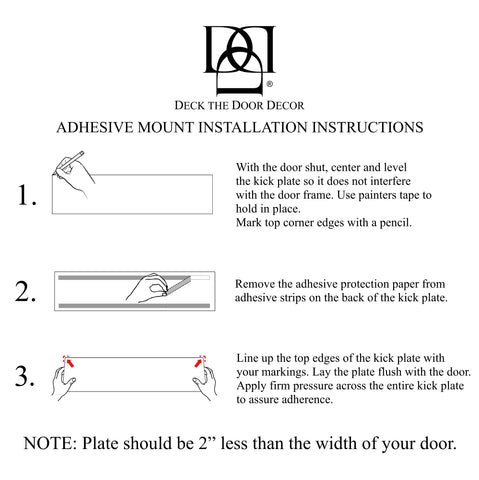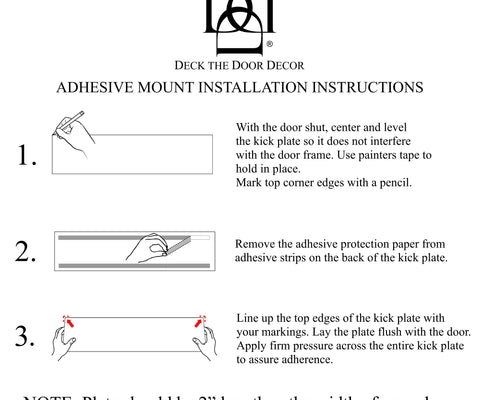
That’s where temporary adhesives come in. Instead of permanent, hard-to-remove methods, you can use strong, removable products to attach a kick plate—no screws, no regrets. But here’s the catch: not every glue sticks well to metal or wood, and some can leave gooey messes behind. So what’s actually best for the job? Let me walk you through the top options (brands included), how they work, and where they shine.
Why Choose Temporary Adhesives for Kick Plates?
Honestly, there are plenty of reasons you’d want a temporary fix. If you’re in a rental, your landlord probably won’t love extra holes in the door. Or maybe you like changing up the look of your entryway from time to time. Temporary adhesives allow you to attach a kick plate securely but also give you the flexibility to pull it off later—hopefully without any leftover sticky disasters.
Using adhesives instead of screws means less damage to the door itself. If you’ve ever tried to fill and paint over screw holes, you know it rarely looks as good as new. With the right adhesive, your door stays hole-free, and the kick plate still does its job. Plus, it’s just faster and less work—no need to dig out the drill, just peel and stick.
Of course, not all adhesives are created equal. Some peel right off but don’t hold well; others stick so well that they’re just as permanent as screws. The trick is finding that sweet spot: strong, but still removable, with no gunk left behind. And trust me, there are a handful of products that do this really well.
Top Adhesives for Temporary Kick Plate Installation
Let me explain the main types you’ll find on shelves (or online carts). When I say “adhesive,” I’m talking about products like *double-sided mounting tape*, *removable gel adhesives*, or even *adhesive putty*—not regular glue or goopy construction adhesive. Here are the superstars:
- 3M Command Strips: Yep, the same brand you use for picture hangers. Heavy-Duty versions are designed to hold several pounds, and they pull off cleanly.
- Gorilla Mounting Tape: Extra-strong, double-sided, and weather-resistant. This stuff can handle outdoor doors where the weather changes, but still peels away.
- VELCRO Brand Industrial Strength Tape: The hook-and-loop design means you can even remove the entire kick plate for cleaning without starting from scratch.
- Scotch Removable Mounting Putty: For lighter kick plates (like plastic or thin aluminum), putty can work in a pinch—and it’s easy to clean up.
I’ve seen people try regular double-sided Scotch tape or hot glue, but those either don’t hold long enough or leave a mess. Stick with products specifically made to be strong but removable.
How to Apply Temporary Adhesives to Kick Plates
Here’s the thing: even the best adhesive can fail if you don’t prep your surface. Before you start sticking anything, make sure both the kick plate and the door are totally clean and dry. Wipe them down with rubbing alcohol (not just soapy water) to get rid of grease, dust, or old wax.
Once your surfaces are ready, follow these steps:
- Measure and mark: Use painter’s tape or a pencil to outline where your kick plate will go. This saves you from re-sticking over and over.
- Cut adhesive strips to size: For Command Strips or Gorilla Tape, measure and snip to fit the back of your kick plate. Place strips along the edges and at the center for even support.
- Attach adhesive to the kick plate: Press strips or dots firmly onto the back of the plate, then peel off the backing.
- Stick to the door: Press the kick plate to the door, using your marks to line it up. Apply firm, even pressure for 30–60 seconds to help it bond.
- Let it set: Some adhesives need a little time to “cure” for full strength—read the instructions. Don’t test or tug right away.
If you’re using Velcro tape, stick one side to the door and the other to the kick plate, then press them together. You can even remove and wash the kick plate when needed.
Comparing Strength: Which Adhesive Holds Up Best?
You might be wondering, “Will these actually keep a kick plate on, especially with all the kicking?” Good question. Here’s a quick rundown, from strongest to lightest:
| Gorilla Mounting Tape | Super strong; good for metal or heavy brass kick plates; also sticks to rougher surfaces. Harder to remove than Command Strips but still doable. |
| 3M Command Strips (Heavy-Duty) | Ideal for smooth doors and medium-weight plates. Removes cleanly but can struggle outdoors or with very heavy materials. |
| VELCRO Brand Tape | Flexible and lets you remove the kick plate when needed; slightly less “permanent” hold than tape, but holds up well indoors. |
| Removable Putty | Best for very light, temporary jobs or plastic kick plates; not recommended for frequent kicking or outdoor use. |
Personally, for most metal kick plates and busy households, I’d go with either Gorilla Mounting Tape or 3M Command Strips. If you have pets or kids who are likely to bump the door a lot, err on the side of heavy-duty.
Common Problems and How to Troubleshoot Them
Sometimes things don’t stick the way you want. Maybe the plate falls off after a week, or you end up with sticky residue. Let’s walk through a few common hiccups and how to fix them:
- Adhesive won’t stick: Check if your surfaces are truly clean and dry. Oil, dust, or even old polish can prevent a solid bond. Rubbing alcohol should fix this.
- Kick plate slips or peels: You might be using too little adhesive, or there’s too much pressure from foot traffic. Add extra strips, especially along the edges.
- Residue left behind: If any sticky gunk stays after removal, use Goo Gone, rubbing alcohol, or even cooking oil. Let it sit, then gently scrape off with a plastic card—never anything metal.
- Weather exposure: For exterior doors, always use weather-resistant adhesives (like Gorilla Mounting Tape) or shield the area from rain whenever possible.
Tip: If you ever want to switch back to screws later, temporary adhesives leave you with a clean slate—no patch-up jobs required.
When Temporary Adhesives Aren’t the Best Solution
Let me be honest: adhesives aren’t perfect for every kick plate situation. If you’re working with a super-heavy plate (thick brass, solid steel) or your door is extremely textured, temporary adhesives might not hold up long-term. Also, in damp or humid climates, some tapes can weaken over time.
For high-traffic commercial doors or exterior areas exposed to wild weather, you might need to bite the bullet and use screws (with proper anchors). That said, for most homes and rental situations, the right adhesive does the trick nicely—at least for a season or two.
If you try an adhesive and find it’s not holding, you can always upgrade to mechanical fasteners down the road. The whole point here is flexibility: test it, see what works, and adjust if you need to.
How to Remove Temporary Adhesives Without Damaging Your Door
Here’s the best part about using quality temporary adhesives: removal is usually a breeze. For Command Strips, gently pull the tab straight down and the adhesive releases cleanly—no fuss. With Gorilla Tape or Velcro, slowly peel back at a sharp angle. If any residue remains, a little rubbing alcohol on a soft cloth should handle it.
If you ever run into a stubborn patch, don’t panic. Soak a rag in warm, soapy water or oil and hold it over the gunk for a couple of minutes to soften it up. Patience really pays off here—scrubbing too hard can scratch the finish.
Just make sure you don’t use anything sharp to scrape, and always test any cleaning product on a hidden corner first. The last thing you want is to swap sticky residue for an ugly scratch or faded paint.
Final Thoughts on Installing Kick Plates Without Screws
Kick plates keep your doors looking sharp and protected—but you don’t always need to break out the drill. With the right temporary adhesive, you get a strong hold, easy installation, and the freedom to remove or swap out your kick plate whenever you want. Whether you’re a renter, a design fanatic, or just want to avoid patching holes, there’s a solution here that fits your needs.
Honestly, once you’ve tried adhesive kick plate installs, you might never go back to screws. It’s a cleaner, faster, and way less stressful way to get the protection your door deserves—no tools, no holes, just a solid stick and peace of mind.
